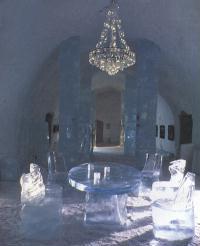Ice Palace
2000/05/16 Roa Zubia, Guillermo - Elhuyar Zientzia

We live in a time of technological dependence. For example, it is becoming more and more complex that traps every corner of the city. In addition, art is also used in buildings. An example is the Guggenheim Museum. In a Swedish village every year another beautiful example is built: an ice and snow palace.
In ancient times Greek and Egyptian buildings remain standing due to their stable structure and durable materials. However, the ice palace only lasts five months. Of course, ice does not have the characteristics of marble. And there is the key and charm of this palace.
Curiosity of those times
Ice palaces are not today's invention. The first known constructions date from 1740. It was the result of the desire of a Russian tsar. A couple of courtiers of the time forced him to have the wedding night. He placed guards on the doors to keep them from escaping.
North of the Arctic Circle, 200 kilometers from Jukkasjarvi, each year they build their new palace. It was first built in 1989 to participate in an art exhibition and has since been used as a hotel. It has 37 rooms for 6,000 people a year. Each classroom is designed and built by an artist.
How can it not fall? The main rule for building ice and snow buildings is not to build vertical walls. The interior of the palace consists of arched corridors. The roof is supported by solid columns of transparent ice. In the corridors there are sculptures and this year the throne for the queen of Sweden. Own utensils, such as glasses, are also made of ice.
One of the hotel's authors, architect Mark Szulgit, worked in the desert with moat constructions. He says the technique is the same. The important thing is to avoid tensions. You will work by compacting the material. That is why arch steps are used. They have a height lower than the width.
The right material is obtained by mixing snow and ice. This mixture is compact and hardens at low temperatures (in the area often low to -30ºC). Metal molds are used to make the structures. When the mixture hardens, the molds are removed. There are three sizes: the main steps, the smallest and the rooms. The largest are the first and due to the defects they present, the pillars support the structure.
The ice of the columns, sculptures and windows is collected from the River Torne. It is together and has no power station. The ice it generates is transparent. Special saws are needed to cut the ice, with larger and smaller teeth than those of cutting wood. The pieces of ice are joined with water, because at those temperatures the tail is strong.
It is another of the great challenges of this type of palaces. The hotel must be clarified without producing heat. Projectors supplied by optical fibers and low-watt lamps are used. The palace bar also has neon light, but the general trend is not to introduce many colors. There are thousands of cables on the wall, “frozen”. The temperature inside the hotel is constant 6ºC. Rooms are not designed to stay long. At least in the tá berna some heat occurs when there are people.
The hotel lasts until May. However, the work continues. In summer you have to plan next year. Every year the hotel will be different and there will be constant improvements. In addition, their experience will be reflected in other ice hotels that will be built in Finland and Canada. Possibility to work art for architects and artists. Curiosity for visitors.
More information at www.jukkas.se

Gai honi buruzko eduki gehiago
Elhuyarrek garatutako teknologia






